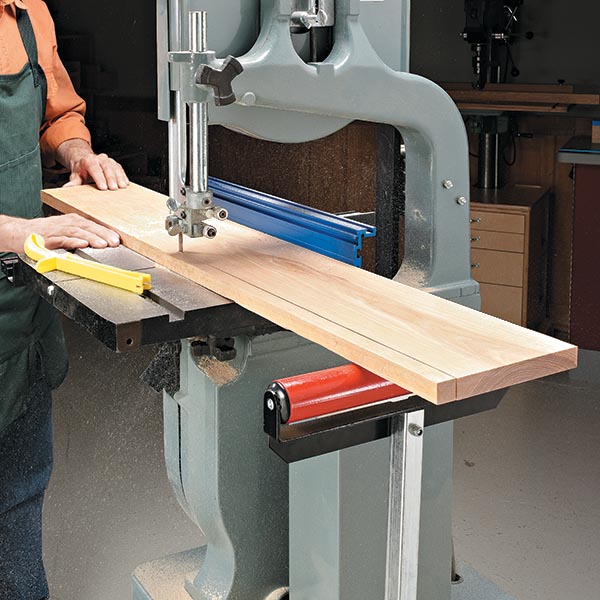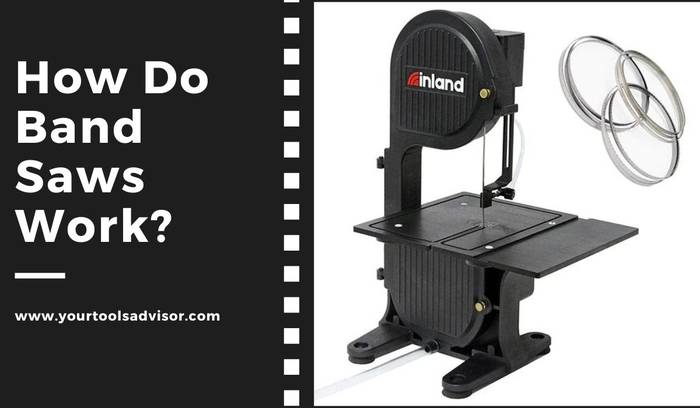Band saws work by using a continuous blade with teeth to cut through materials, powered by an electric motor. Band saws are versatile power tools commonly used in woodworking and metalworking industries for cutting curves, straight lines, and irregular shapes.
Unlike other saw types, band saws have a continuous blade that rotates around two wheels. One wheel is powered by an electric motor, causing the blade to move in a continuous loop.
The teeth on the blade’s edge gradually cut through the material as it passes through the workpiece. This design allows for smooth and precise cutting, making band saws ideal for intricate and detailed cuts.
With their adjustable blade guides, tensioning mechanisms, and various blade options, band saws can handle a wide range of materials, including wood, metal, and plastics.
In this blog post, I am going to share a detailed discussion on how do band saws work. So, if you want to know more about the working mechanism of band saws, then you can study the following discussion.
So, here we go…
Understanding The Basics
When it comes to woodworking or metalworking, a band saw is an indispensable tool. If you’re new to using a band saw or want to know more about how it works, this section will give you a detailed understanding of the basics.
Let’s take a closer look at the components of a band saw and the anatomy of a band saw blade…
Components Of A Band Saw
A band saw consists of various components that work together to create accurate and precise cuts. Understanding each of these components will help you operate the band saw correctly and maintain its performance.
Here are the key components of a band saw:
- Base: The base provides stability and support to the entire band saw. It is usually made of a sturdy material like cast iron or steel to ensure durability.
- Table: The table is the flat surface where the workpiece is placed during cutting. It can be tilted to accommodate angled cuts and usually has a miter gauge for making precise angled cuts.
- Blade Guard: The blade guard is a safety feature that covers the band saw blade to prevent accidental contact with the rotating blade during operation.
- Blade Tension Knob: The blade tension knob is used to adjust the tightness of the blade. Proper blade tension is essential for achieving accurate cuts.
- Blade Guide: The blade guide consists of guide bearings or blocks that help support and guide the blade, ensuring it stays on track and prevents excessive vibration.
- Upper Wheel: The upper wheel is a large wheel located at the top of the band saw. It is connected to the motor and powers the rotation of the blade.
- Lower Wheel: The lower wheel is another large wheel located at the bottom of the band saw. It helps guide the blade and works in conjunction with the upper wheel to provide continuous movement.
- Motor: The motor is responsible for powering the band saw and driving the rotation of the blade. It can be either electric or belt-driven, depending on the model.
Anatomy Of A Band Saw Blade
The band saw blade is the cutting component of the band saw and plays a crucial role in determining the type and quality of cuts you can achieve.
Understanding the anatomy of a band saw blade will give you insights into its capabilities and help you select the right blade for your woodworking or metalworking needs.
Here are the key parts of a band saw blade:
- Teeth: The teeth of the blade are responsible for cutting through the material. They come in different sizes, configurations, and tooth patterns, allowing for various cutting applications.
- Gullets: The gullets are the space between the teeth. They help remove the chips and debris created during the cutting process, preventing them from clogging the blade.
- Backing Material: The backing material of the blade provides rigidity and support to the teeth. It can be made of carbon steel, high-speed steel, or carbide-tipped depending on the blade’s intended use.
- Blade Width: The blade width refers to the distance between the blade’s toothed edge and its back edge. It determines the minimum radius the blade can cut and affects the blade’s stability during operation.
- Blade Length: The blade length is the total length of the blade, including the portion that wraps around the band saw wheels. It is an essential measurement when replacing or selecting a new blade.
Understanding the components of a band saw and the anatomy of a band saw blade is crucial for anyone looking to achieve precise and efficient cuts.
Now that we’ve covered the basics, you’re ready to dive deeper into the world of band saws and explore their capabilities.

Credit: www.woodsmith.com
How Do Band Saws Work?
A band saw is a versatile cutting tool commonly used in woodworking, metalworking, and various other industries. At its core, a band saw operates through the use of a continuous looped blade, which is typically made of a durable material like steel or carbide. This blade is stretched around two wheels, with one positioned above and the other below the work surface.
The upper wheel is connected to a motor, providing the necessary power to drive the blade. When the motor is activated, the wheels start to spin, causing the blade to move in a continuous loop.
As a result, the cutting action of a band saw is achieved by feeding the material into the moving blade, allowing it to make precise and controlled cuts.
One of the key advantages of a band saw is its ability to handle curved and irregular shapes with ease. The thin, flexible blade allows for intricate cuts that may be challenging for other cutting tools.
Additionally, the adjustable speed settings of the motor provide control over the cutting process, enabling users to tailor the blade’s speed to match the specific material being worked on.
This versatility makes band saws a popular choice for a wide range of applications, from cutting intricate patterns in woodworking to making precise cuts in metal fabrication.
Blade Tension And Tracking
Blade tension and tracking are crucial aspects of understanding how a band saw operates. These elements play a significant role in ensuring the proper functioning and effectiveness of the machine.
In this particular section, we will explore the importance of blade tension, how to adjust it, and the proper blade tracking techniques to achieve optimal results.
Importance Of Blade Tension
Blade tension is a vital factor that directly affects the performance and cutting accuracy of a band saw. Maintaining the correct blade tension is necessary to achieve precise cuts and prolong the life of the blade.
When the blade is properly tensioned, it remains securely positioned on the wheels, minimizing the risk of slippage or veering during operation. This ensures that the saw effectively cuts through the material in a straight and controlled manner.
Adjusting Blade Tension
Properly adjusting the blade tension is essential to optimize the performance of a band saw. The tension should be tight enough to prevent the blade from slipping off the wheels, but not overly tight as it may lead to premature wear and potential breakage.
Here are some steps to adjust the blade tension:
- Ensure the band saw is turned off and unplugged.
- Refer to the manufacturer’s instructions for locating the tension adjustment knob or lever.
- Loosen the tension by carefully turning the knob or releasing the lever.
- Place the blade in the desired positioning, ensuring it rests properly on the wheels.
- Tighten the tension by gradually turning the knob or engaging the lever until the desired tension is achieved.
- Check the tension by gently plucking the blade. It should produce a clear, audible sound.
Remember, it’s important to strike a balance when adjusting the blade tension. By employing just the right amount of tension, you can optimize cutting precision and prolong the life of your blade.
Proper Blade Tracking
Blade tracking refers to the alignment of the blade on the band saw wheels. Correct blade tracking ensures that the blade is properly positioned, avoiding unnecessary wear, vibrations, and potential damage.
Here are some steps to achieve proper blade tracking:
- Start by turning off and unplugging the band saw.
- Locate the blade tracking adjustment knob or screw, which is typically found on the upper wheel housing.
- Make small adjustments to the tracking by turning the knob or screw incrementally.
- Observe the blade as it travels on the wheels. Ideally, it should run at the center of the wheel, without touching the wheel’s edge.
- Continue adjusting as necessary until the blade is perfectly aligned and properly tracking.
By following these steps, you can ensure that your band saw’s blade is properly tracked, resulting in smoother cuts and increased blade longevity.
Cutting Techniques
Band saws are essential cutting tools utilized in various woodworking applications. By using a continuous loop of toothed metal, these machines create precise cuts through a variety of materials, making them a reliable choice for both professionals and beginners in the woodworking field.
Straight Cuts With A Band Saw
One of the primary cutting techniques performed with a band saw is making straight cuts. Band saws are known for their ability to make precise and clean cuts, which is why they are a staple in woodworking shops. The process of making straight cuts with a band saw is relatively straightforward.
The first step is to set up the band saw properly. This involves adjusting the tension of the blade and ensuring that it is tracking correctly. Once the band saw is properly set up, you can proceed with making your cut.
To make a straight cut with a band saw, you need to guide the stock along a straight line while gently pushing it into the blade. Take your time and let the saw do the work. Applying too much force can result in a rough cut or even blade damage. Maintain a steady pace and let the band saw’s sharp teeth effortlessly slice through the material.
If you’re looking to make consistently straight cuts, consider using a fence or a guide. A fence is a useful accessory that can be attached to the saw’s table, allowing you to guide the stock along a predetermined path. This ensures accurate and repeatable cuts, ideal for projects that require precision.
Making Curves With A Band Saw
The band saw’s versatility extends beyond straight cuts, as it can also be used to create curves. This makes it a popular choice for woodworking projects that involve intricate designs or detailed craftsmanship.
To make curves with a band saw, start by marking the desired curve on your stock. It’s important to keep in mind that the minimum radius of the curve will depend on the width of the blade. Thinner blades allow for tighter turns, while wider blades are better suited for gentler curves.
Once you have marked the curve, carefully maneuver the stock along the line, making sure to maintain a steady pace. Take into consideration the speed at which the blade is cutting and adjust accordingly to achieve the desired curve. Remember, the key to successful curve cutting is smooth and controlled movements.
Resawing And Ripping
Resawing and ripping are cutting techniques frequently used in woodworking. Resawing involves cutting a board horizontally, resulting in two thinner boards. Ripping, on the other hand, refers to cutting a board parallel to its grain, resulting in narrower strips of wood.
Band saws excel at both resawing and ripping. Their sharp and thin blades make the process efficient and accurate. To ensure clean and precise cuts, it’s important to use a suitable blade with an appropriate number of teeth per inch (TPI).
When resawing, choose a blade with a lower TPI to provide efficient chip removal and prevent the blade from getting clogged. This allows the blade to glide through the material smoothly, resulting in straight and smooth cuts.
When ripping, a blade with a higher TPI is recommended to ensure a cleaner cut. The increased number of teeth allows for finer control and reduces the chance of tear-out along the cut line.
Remember to always use appropriate safety measures, such as wearing protective equipment and securing the stock before cutting, to ensure a safe and successful resawing or ripping operation.
Read More: Where Should You Buy Band Saw Blades From?
Maintenance And Safety
When it comes to operating band saws, a crucial aspect that often gets overlooked is maintenance and safety. Proper maintenance not only extends the lifespan of your band saw but also ensures optimal performance and reduces the risk of accidents.
Additionally, adhering to safety precautions is essential to protect yourself and others around you.
In this section, we will discuss important maintenance tips, common safety precautions, and troubleshooting common band saw issues.
Band Saw Maintenance Tips
Maintaining your band saw regularly is essential to keep it in good working condition.
Here are some maintenance tips:
- Keep the band saw clean: Regularly clean the saw, removing any sawdust or debris that can hinder its performance. Use compressed air or a brush to clean hard-to-reach areas.
- Inspect the blade: Check the blade for any signs of wear or damage. Replace the blade if it is dull, worn, or damaged.
- Tension the blade correctly: Proper blade tension is crucial for accurate cuts and safe operation. Follow the manufacturer’s guidelines to ensure the blade is properly tensioned.
- Lubricate moving parts: Apply lubricant to the moving parts of the band saw, such as the guides and wheels, to minimize friction and enhance smooth operation.
- Check the alignment: Regularly check the alignment of the blade and guides to ensure they are properly aligned. Misalignment can lead to poor cuts and increased wear on the blade.
FAQs For How Do Band Saws Work
How Do Band Saws Operate Band Saws?
Band saws operate by using a continuous loop of toothed metal called a band. The band is mounted on wheels and driven by a motor, allowing it to cut through various materials. The blade’s teeth cut into the material, creating a clean and precise cut.
How Does A Band Saw Cutting Machine Work?
A band saw cutting machine works by using a continuous band with teeth to cut through various materials. The blade moves in a continuous loop around two wheels, allowing for precise and efficient cutting. The material is fed into the blade, which cuts it into the desired shape or size.
How Do You Use A Bandsaw For Beginners?
To use a bandsaw for beginners, first, familiarize yourself with the machine’s safety instructions. Then, adjust the blade tension and ensure it’s properly aligned.
Next, secure your workpiece and turn on the bandsaw. Gently guide the material through the blade, making smooth, controlled cuts. Remember to practice and take safety precautions.
What Are The Disadvantages Of A Band Saw?
The band saw has a few drawbacks, such as limited cutting depth and the need for frequent blade changes. Additionally, it can be difficult to make intricate cuts or smooth curves with a band saw.
Conclusion
Band saws are versatile cutting machines commonly used in woodworking and metalworking industries. By employing a continuous band of teeth, these saws efficiently cut through various materials with precision and speed.
Understanding their mechanism is crucial for optimal performance and safety. By knowing how band saws work, you can enhance your woodworking or metalworking skills and create intricate designs effortlessly.
So, grab your band saw and start sawing your way to creative masterpieces!





Leave a Reply